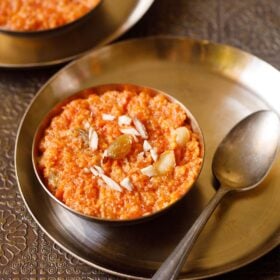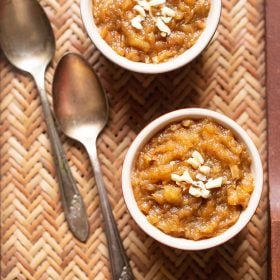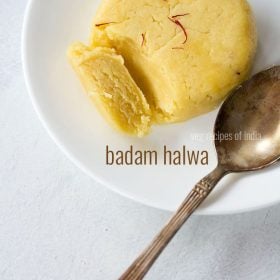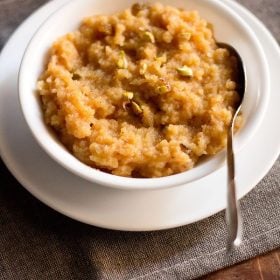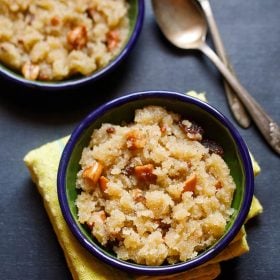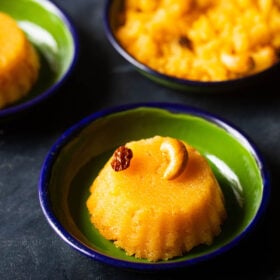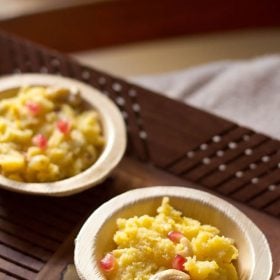Just like any other Indian, me and my family are also big fans of one of the most popular forms of Indian desserts known as the Halwa. And when it is the season of the ‘king of fruits’ a.k.a mango, it is mandatory for me to make a halwa too with this amazing fruit. This Mango Halwa recipe is one of those from my kitchen that is simple and heroes this seasonal fruit in all its glory. Its quite addictive too. But I’ll always say, its absolutely okay to indulge once a while with this beautiful homecooked aam halwa.
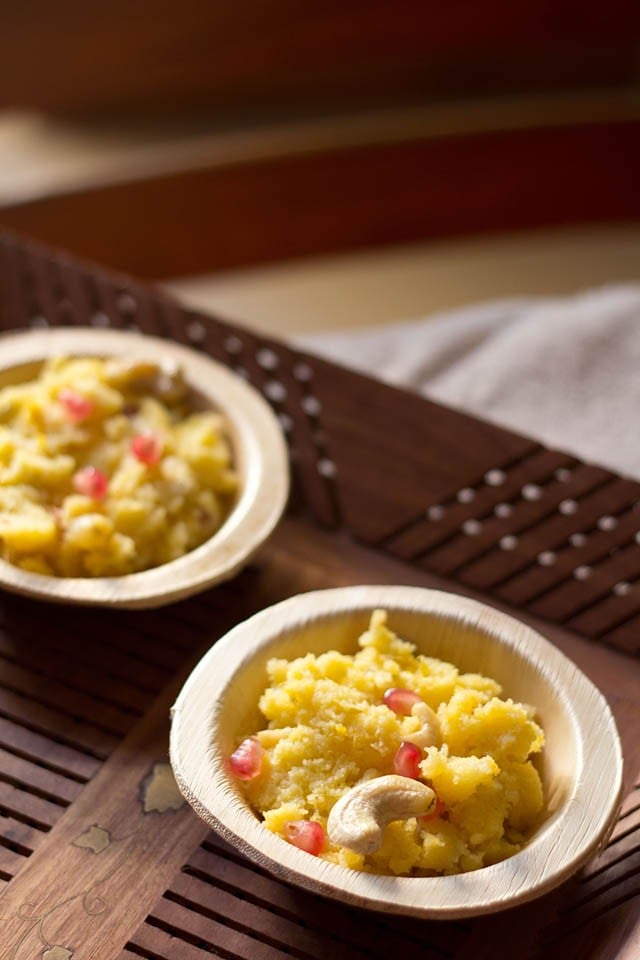
About Mango Halwa
There is no rocket science, when it comes to making this Mango Halwa too. So, besides the fresh ripe mango puree, this sweet and smooth pudding requires just your usual halwa ingredients. Like semolina (rava or suji), sugar, ghee and milk. Additional flavorings include nuts, dry fruits, saffron and some cardamom.
I love Alphonso mangoes. It is the quintessential mango variety in Maharashtra and other parts of western India. So, I inevitably end up using medium to large-sized fresh and ripe Alphonsos for this Mango Halwa recipe too. Pulp or puree these, and you are good to go.
Like I said, this recipe of Mango Halwa is exactly the way you would make any other halwa. The addition of the lovely mango pulp is what gives this halwa, the desired mangoness in its flavors and aroma.
One thing that you can also keep in mind is to adjust the quantity of the sugar. This will depend on how sweet the mangoes you are using are.
In this Mango Halwa recipe, large variety of Indian mangoes are used. For a halwa, any mango with a good firm texture and flesh can be used. Just don’t use mangoes which are fibrous. So, apart from Alphonso, Kesar mangoes are also good. It’s also absolutely fine to go ahead and experiment with other sweet, non-fibrous varieties of mangoes too.
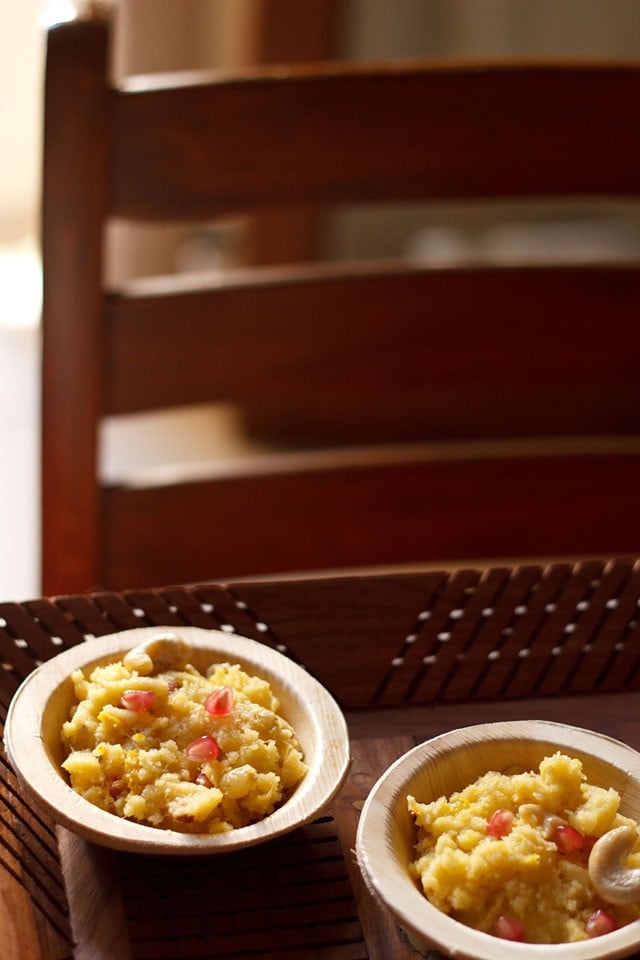
Another similar recipe that I prepare at times is this Mango Kesari. The ingredient make-up is almost the same in this one too. However, the end result is a smoother version that is very typical of the South Indian versions. Of course, Kesari is what halwa is, in all of South India.
What’s special about this Mango Halwa
The origin of this particular Mango Halwa lies in my mother’s book of recipes, which eventually was passed to me. Like most Indian women, she also is not a fan of using measuring spoons or cups for measuring ingredients in her recipes. So, she gave me approximate measures, and I quantitatively deduced the measurements for this recipe.
Another thing about the Mango Halwa recipe that I have shared on this post is the way you can actually add to the flavors or not do it at all. So, like I have used the nuts, saffron and a bit of cardamom for that extra kick, you can choose to not add any of it. I mean if you are a mango fanatic, you may just enjoy the halwa in all its mango supremacy, without any additional flavorings.
Or you can select the flavorings, and add may be just one or 2 of them, depending on how your palate would like it. I also love the burst of zing that fresh pomegranate pearls, added as a garnish towards the end, impart in this Mango Halwa. You have the choice to skip it too. I also think some fresh mint sprigs will go great with the halwa – adding to the looks as well as the taste.
All in all, make the most of the mango season by making this Mango Halwa as many times as you can. It is one cracker of a dish, and I say this not just because it is a very dear recipe to me, but also because its super simple, non-fussy and makes for a great fruity variation to your regular rich Indian desserts. For more such recipes you can check this collection of Mango Recipes.
Expert Tips
- Choosing mango variety: I have an affinity towards Alphonso. So, that is what I always use for this halwa recipe too. But you can use any other ripe, sweet and non-fibrous mango variety.
- Using canned mango puree: Of course, this halwa recipe can be made using canned or readymade mango puree or pulp as well.
- Adjusting sweetener: If you are using mangoes that are extremely sweet, I’d rather say to use less sugar. However, depending on the sweetness you are fond of in your desserts, you can add less or more of the sugar in the recipe.
- Adding dry fruits: My choice of nuts & dry fruits includes cashews, raisins and charoli (chironji) for this halwa. I have fried them as it just enhances the flavors. But you can also add without frying them. But make sure to use dry fruits that are in their shelf-life, and not rancid or bitter.
- Scalability: This recipe of Mango Halwa can easily be scaled to make for larger portions.
More Halwa Recipes To Try!
Sweets Recipes
Halwa Recipe
Halwa Recipe
Halwa Recipe
Please be sure to rate the recipe in the recipe card or leave a comment below if you have made it. For more vegetarian inspirations, Sign Up for my emails or follow me on Instagram, Youtube, Facebook, Pinterest or Twitter.
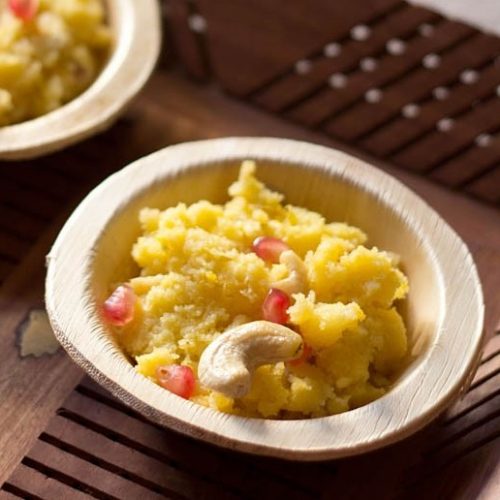
Mango Halwa
Ingredients
- 1 cup suji (fine textured rava or semolina)
- 1 mango medium to large, (alphonso or any other variety), chopped and pureed or ½ cup mango puree
- ½ cup sugar or as required
- 2 tablespoons Ghee or oil
- 1 cup milk
- 1.5 cups water
- 2 tablespoons nuts – chopped, cashews, charoli (chironji) as required
- 1 tablespoon raisins
- 1 pinch saffron
- 3 to 4 green cardamoms or ½ teaspoon cardamom powder
- 1 tablespoon pomegranate arils – for garnish
Instructions
- Powder the cardamom pods in a mortar pestle and discard the husks.
- Heat ghee or oil in a thick bottomed pan or kadai. Keep heat to medium-low or medium.
- Add the sooji or rava and roast often until they change color and you get a lovely aroma.
- Add the nuts, raisins and continue to roast for a few minutes.
- Heat 1.5 cups of water separately in a pan on the stovetop.
- Add this hot water gently to the rava and nuts mixture. Stir and mix very well.
- Add milk and sugar. Continue to stir and mix. Milk can be at room temperature or hot.
- The semolina granules absorbs both water and milk and will swell.
- You have to stir continuously so that the mixture does not stick at the bottom of the pan.
- After 1 or 2 minutes, add the mango pulp.
- Stir and mix again well and ensure that the mango pulp is mixed thoroughly.
- Add cardamom powder and saffron.
- Continue to stir until the liquids and moisture reduce.
- Cover with a lid and cook mango halwa for 1 or 2 minutes more until you see that all the liquids have been absorbed and the halwa looks slightly glossy or shiny with the ghee releasing from it.
- Garnish Mango Malwa with extra cashews or pomergranate arils.
- Serve the the Mango halwa hot, warm or even cold.
Notes
- Use fine textured rava or sooji. It gives better texture and consistency.
- Feel free to use any pulpy and fleshy varieties of mangoes instead of alphonso mango.
- The color of the halwa will vary with the kind of mangoes used.
- Sugar can be adjusted according to the sweetness of the mangoes and according to your taste preferences.
Nutrition Info (Approximate Values)
This Mango Halwa recipe from the blog archives was first published on May 2013. It has been updated and republished on May 2024.
